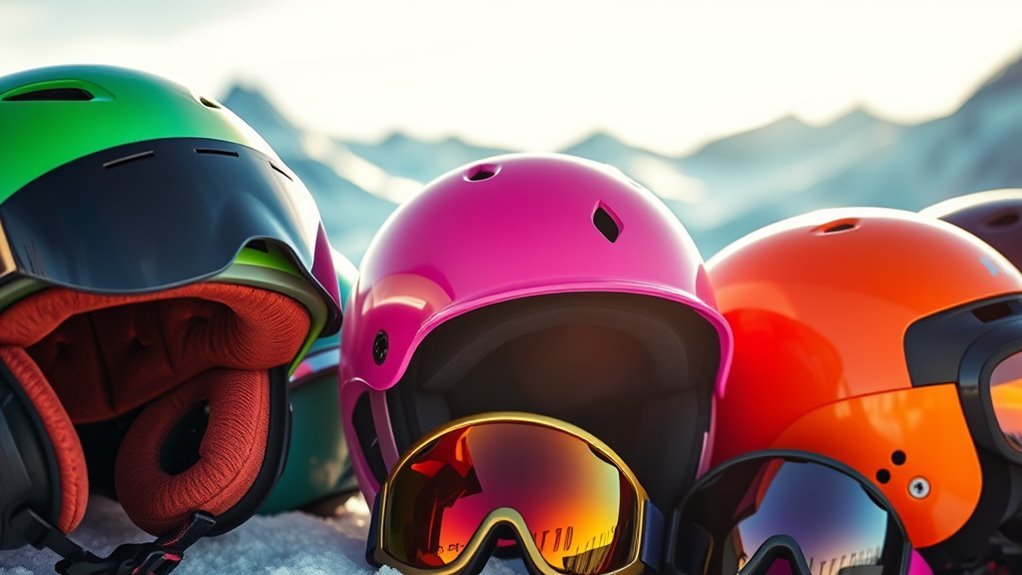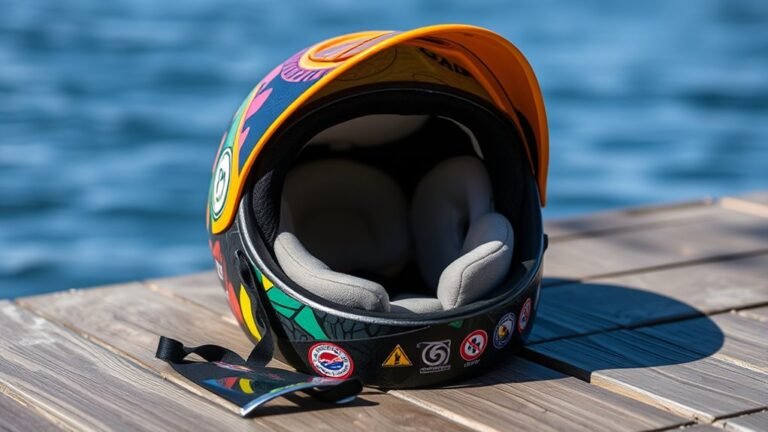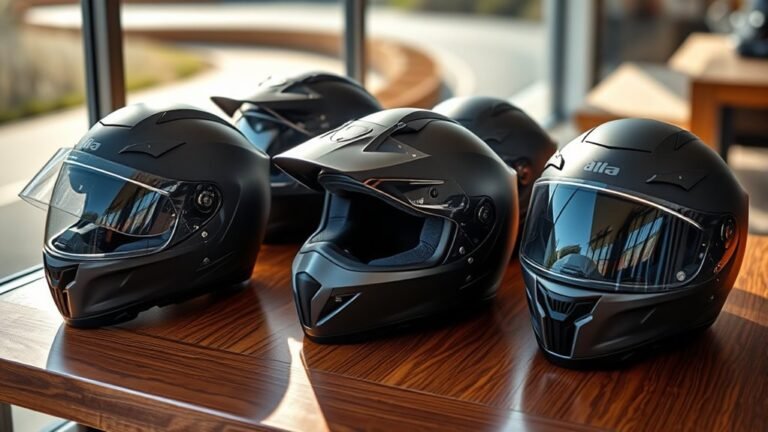Choosing the Right Ski Helmet for Safety and Comfort
Choosing the right ski helmet is essential for your safety and comfort on the slopes. Look for certified models that meet safety standards like ASTM or CE. Guarantee a snug fit by measuring your head circumference and adjusting the chin strap. Consider lightweight helmets for agility or heavier models for added protection. Don’t overlook ventilation features and moisture management for comfort. As you explore, you’ll discover additional factors to enhance your ski helmet selection.
Understanding Ski Helmet Safety Standards
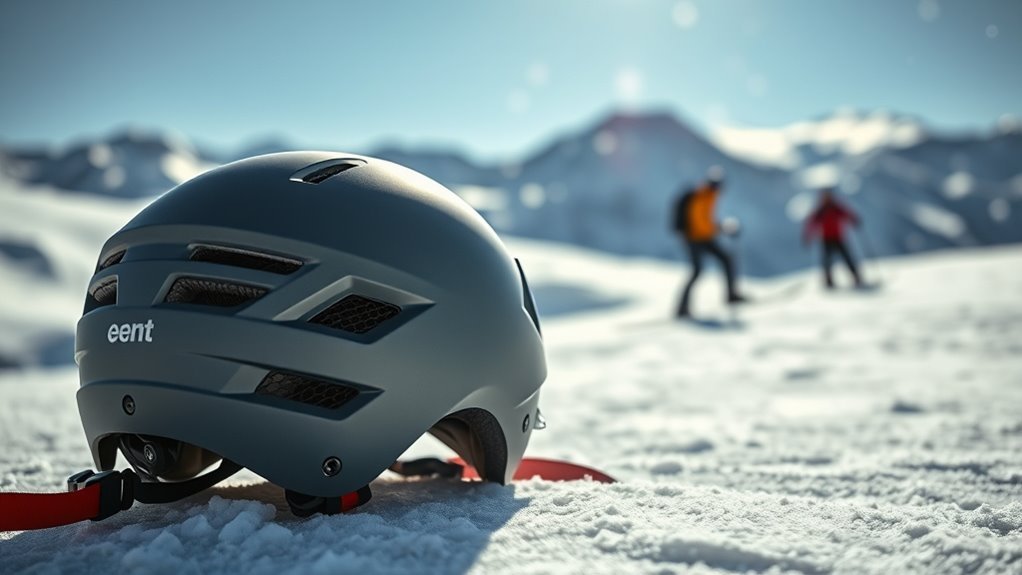
When it comes to skiing, understanding helmet safety standards is essential for your protection on the slopes. To verify your helmet meets safety requirements, look for proper helmet certification from recognized organizations, such as ASTM or CE. These certifications indicate that the helmet has undergone rigorous testing procedures to evaluate its impact resistance and overall performance.
During these testing procedures, helmets are subjected to various impacts and conditions to confirm they can withstand the rigors of skiing. Always check for these certifications before making a purchase, as they directly correlate with your safety. Remember, a high-quality helmet not only protects your head but also gives you the confidence to enjoy your skiing experience freely and without worry.
Types of Ski Helmets: Which One Is Right for You?
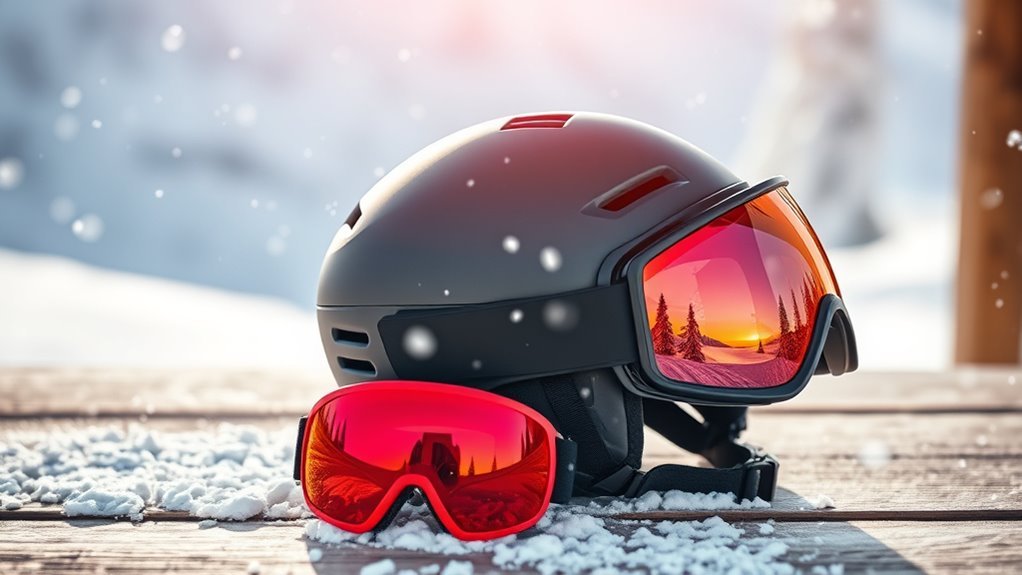
When choosing the right ski helmet, you’ll encounter different types, including hard shell and soft shell options. Additionally, consider whether you need a full-face or half-face design based on your skiing style and safety requirements. Understanding these differences will help you make an informed decision that enhances your experience on the slopes.
Hard Shell vs. Soft Shell
Which type of ski helmet should you choose: hard shell or soft shell? Understanding the differences can help you make an informed decision.
| Feature | Hard Shell | Soft Shell |
|---|---|---|
| Material | Rigid plastic | Flexible foam |
| Protection Level | High impact resistance | Moderate impact resistance |
| Weight | Heavier | Lighter |
| Breathability | Less breathable | More breathable |
| Use Case | Aggressive skiing | Casual skiing |
Hard shell benefits include superior impact protection, making them ideal for aggressive skiing. On the other hand, soft shell flexibility offers more comfort and breathability, perfect for those who prefer a relaxed ride. Choose the helmet that aligns with your skiing style and safety needs.
Full-Face vs. Half-Face
How do you choose between a full-face and a half-face ski helmet? Your decision hinges on the balance between protection and freedom. Full-face helmets offer significant advantages, like enhanced coverage for your chin and jaw, making them ideal for aggressive skiing or snowboarding. They provide superior impact protection, especially during high-speed runs or in competitive settings. However, the added weight and restricted airflow can be drawbacks for some, making them feel less comfortable during long days on the slopes. Half-face helmets, while lighter and more breathable, have their drawbacks; they expose more of your face, increasing vulnerability during falls. Ultimately, consider your skiing style and comfort preferences to determine which helmet type fits your needs.
Importance of Proper Fit and Sizing
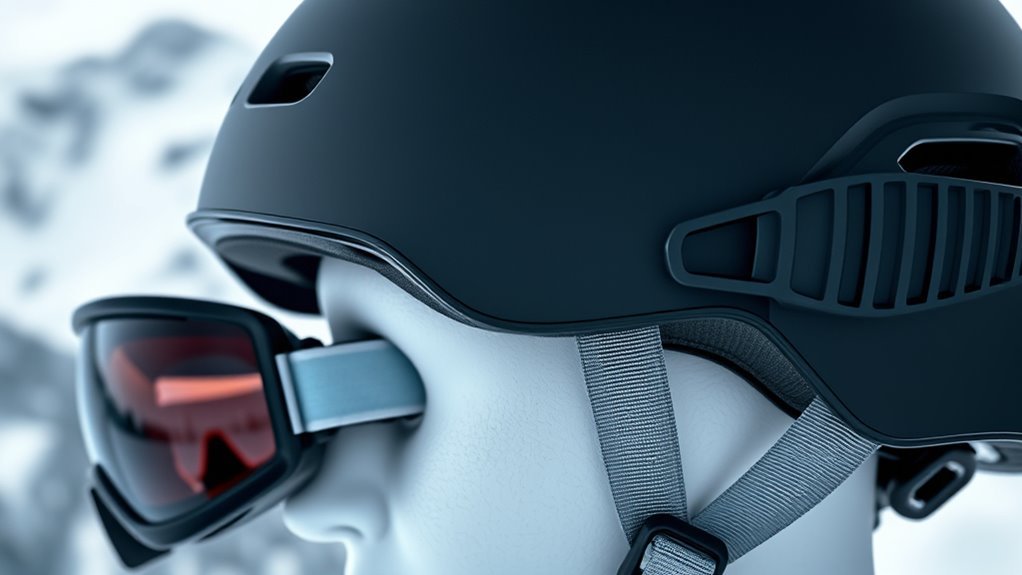
Since a ski helmet is your first line of defense against head injuries, ensuring it fits properly is essential for both safety and comfort. Start by taking proper measurements of your head, typically around the forehead just above the ears. Use these measurements to find your size according to the manufacturer’s sizing chart. When trying on helmets, use fitting techniques like the “shake test”—your helmet should stay put without excessive movement. It should feel snug but not overly tight, allowing for some room to breathe. Don’t forget to adjust the chin strap for a secure fit. Remember, a well-fitted helmet not only protects you but also enhances your overall skiing experience, giving you the freedom to enjoy the slopes confidently.
Lightweight vs. Heavier Models: Finding Your Preference
When selecting a ski helmet, you’ll find that the choice between lightweight and heavier models can considerably impact your performance on the slopes. Lightweight helmets offer significant benefits, such as enhanced comfort and increased mobility, allowing you to ski longer without feeling fatigued. They’re often preferred by those who value agility and freedom of movement. On the other hand, heavier models can provide additional protection and durability, but they come with drawbacks, like increased bulk and potential discomfort during extended use. Ultimately, it’s important to weigh these factors based on your skiing style and preferences. If you prioritize performance and freedom, a lightweight helmet may be the better choice for you, while a heavier model might suit those needing more robust protection.
Ventilation Features for Comfort on the Slopes
What’s the best way to stay comfortable while skiing? It’s all about choosing the right helmet with effective ventilation features. Look for different ventilation types, such as fixed or adjustable vents, to help regulate your temperature. Adjustable vents allow you to control airflow based on your activity level and weather conditions, keeping you cool when you’re working hard and warm when you take a break. A well-ventilated helmet prevents overheating and moisture buildup, ensuring you stay cozy and focused on the slopes. Remember, comfort is key to enjoying your time on the mountain. So, before you hit the trails, make sure your helmet offers the ventilation features that support your freedom to ski without distractions.
Additional Protective Features to Consider
While choosing a ski helmet, it’s crucial to take into account additional protective features that can enhance your safety on the slopes. Look for helmets equipped with MIPS (Multi-directional Impact Protection System) that can reduce rotational forces during a fall. Some helmets also have built-in audio, allowing you to enjoy music or take calls without removing your gear.
| Feature | Benefit |
|---|---|
| MIPS | Reduces rotational impact |
| Built-in audio | Enjoy music and communication hands-free |
| Adjustable chin strap | Guarantees a secure fit for maximum safety |
The Role of Liner Materials in Comfort and Safety
When choosing a ski helmet, the liner materials play an essential role in both comfort and safety. Different types of liners offer varying impact absorption properties, which can greatly affect your protection during a fall. Additionally, moisture management features in these liners help keep you dry and comfortable on the slopes.
Types of Liner Materials
The liner materials in a ski helmet play an essential role in both comfort and safety. You’ll find various foam types, each offering unique benefits. Expanded polystyrene (EPS) is the most common, providing excellent shock absorption while being lightweight. EPP (expanded polypropylene) also offers durability and flexibility, making it a great choice for those who prioritize longevity. Some helmets feature multi-density foams, which combine different foam types for enhanced comfort and safety. These liners not only cushion your head but also wick moisture away, keeping you dry and comfortable. When choosing a helmet, consider how these liner benefits align with your skiing style and preferences, ensuring you enjoy the freedom of the slopes while staying protected.
Impact Absorption Properties
Choosing the right liner material directly influences a helmet’s impact absorption properties, which are essential for your safety on the slopes. Modern foam technology plays an important role in this aspect, as it’s designed to absorb energy effectively during an impact. High-quality helmets often utilize multi-density foams that compress and deform upon impact, dissipating energy and reducing the risk of injury. This not only enhances your protection but also contributes to overall comfort, allowing for a snug fit without sacrificing freedom of movement. When selecting a helmet, consider the liner’s construction and energy absorption capabilities, as these factors can greatly affect your riding experience and safety while enjoying the thrill of skiing.
Moisture Management Features
How can you stay comfortable on the slopes while ensuring safety? One key factor is the moisture management features of your ski helmet. Look for helmets that incorporate moisture-wicking fabrics and advanced sweat management systems. These materials help pull sweat away from your skin, keeping you dry and comfortable even during intense runs. A well-ventilated helmet designed with these features will prevent overheating, allowing you to maintain focus and enjoy your day on the mountain. Additionally, effective moisture management reduces the risk of discomfort and distractions, which is vital for your safety. When you choose a helmet with superior liner materials, you’re not just prioritizing comfort; you’re enhancing your overall skiing experience. Stay dry, stay safe, and ski freely!
Accessories and Customization Options
While skiing, having the right helmet is just the beginning; accessorizing and customizing can enhance both safety and comfort. You can personalize your helmet to match your style and needs, ensuring you stand out on the slopes. Consider these options:
- Custom graphics to express your personality
- Removable liners for easy cleaning and temperature control
- Goggle clips to secure your eyewear
- Audio systems for enjoying music while you ski
- Face shields for added protection against the elements
These accessories not only improve your experience but also boost safety. By tailoring your helmet, you’ll feel more confident and comfortable, allowing you to fully embrace the freedom of the mountain.
Maintenance Tips for Longevity and Performance
To guarantee your ski helmet lasts and performs at its best, regular maintenance is crucial. Start with effective cleaning techniques; use mild soap and water to wipe down the exterior and interior padding. Avoid harsh chemicals that can damage materials. After each use, make sure your helmet is dry and free from moisture to prevent mold growth.
For storage solutions, keep your helmet in a cool, dry place away from direct sunlight. Consider a padded bag for added protection during transport. Regularly inspect your helmet for any signs of wear or damage, like cracks or loose parts. If you notice any issues, it’s essential to address them immediately to make sure your helmet continues to provide the safety and comfort you need on the slopes.
Frequently Asked Questions
How Often Should I Replace My Ski Helmet?
You should replace your ski helmet every 3 to 5 years, as this is generally the helmet lifespan recommended by manufacturers. Even if it looks fine, materials can degrade over time, affecting safety standards. If you’ve had a significant impact or crash, replace it immediately, regardless of age. Staying aware of these factors guarantees your helmet continues to provide the protection you need, so you can enjoy the slopes with confidence and freedom.
Can I Wear a Beanie Under My Ski Helmet?
Yes, you can wear a beanie under your ski helmet, but there’s a catch. You’ll need to guarantee that the helmet still fits snugly. A beanie can add comfort and warmth, but if it compromises the helmet’s fit, it could be dangerous. Make sure the helmet doesn’t shift or feel too tight. Experiment with different beanies to find one that balances comfort with safety, allowing you to enjoy your time on the slopes.
Are Ski Helmets Suitable for Other Winter Sports?
Yes, ski helmets are suitable for other winter sports, thanks to their versatility. Whether you’re snowboarding, sledding, or ice skating, they provide essential winter sports safety by protecting your head from impacts. Just guarantee the helmet fits well and meets safety standards for each activity. Using the same helmet can save you money and simplify your gear, allowing you to enjoy the freedom of winter sports without compromising on safety.
How Do I Clean My Ski Helmet Properly?
Cleaning your ski helmet is like grooming a trusty steed; it keeps your ride safe and smooth. Start by removing the inner padding and washing it with mild soap and water. For the shell, use gentle cleaning solutions, avoiding harsh chemicals. Wipe with a soft cloth, ensuring you don’t soak it. Make sure to let everything dry completely before reassembling. Regular helmet maintenance tips like this will keep your helmet in top shape for every adventure!
What Are the Best Brands for Ski Helmets?
When it comes to the best brands for ski helmets, you can’t go wrong with top ski brands like Giro, Smith, and POC. These companies prioritize helmet safety while guaranteeing comfort and style. Look for features like MIPS technology, which helps reduce rotational forces during impacts. Always check for certifications to verify you’re getting a reliable product. With the right helmet, you can enjoy the slopes and feel confident in your safety.
